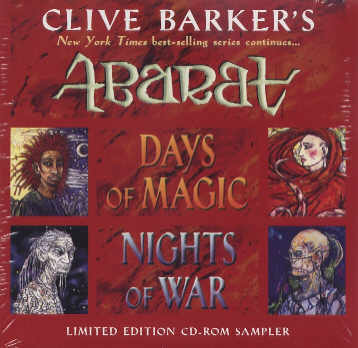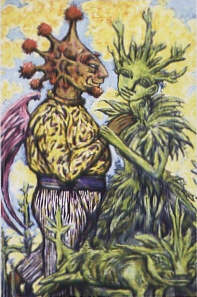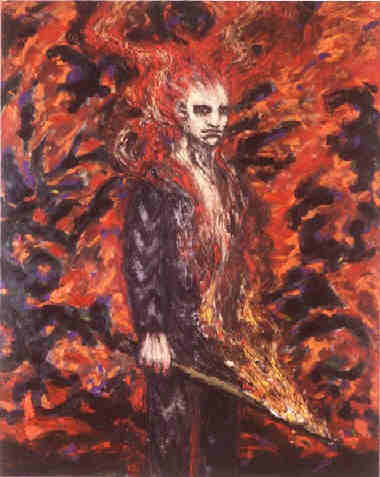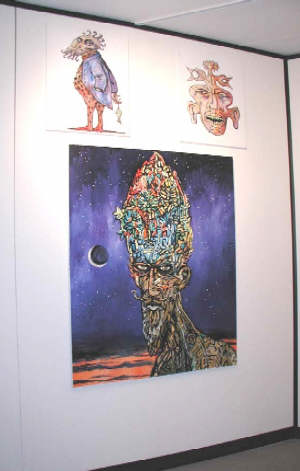In Anticipation Of The Deluge : A Moment At The River's Edge
The Sixth Revelatory Interview - part one
By Phil & Sarah Stokes, 1 / 12 July 2004
With many thanks to Clodagh Nugent. Your help, as ever, is warmly appreciated.
Over the last few months, we've had a series of conversations with Clive in support of Memory, Prophecy and Fantasy. These interviews will eventually find their way into the books, but
they have done nothing to satisfy the constant requests we have for a new interview here on the site...
So, on his return to Los Angeles after appearances in England and Holland, we decided to ignore our normal 'early years'
focus for a couple of weeks and Clive instead spent the time generously agreeing to share
his thoughts on upcoming projects and other plans for the near future...
Clive : "So let's talk - get back into the rhythm!"
Revelations : "Great - we can talk about all the new stuff at last."

Clive : "Absolutely - of which there's a lot."
Revelations : "We'll have to restrain you from talking for an hour on Abarat II."
Clive : "Right, we'll be very careful about that!"
Revelations : "When this interview goes up on the website, people will largely not have read it, will largely not have seen much of the artwork yet."
Clive : "I think all that's true and we should keep it that way. One thing that I saw as I was going round England, and actually around Holland too, was how much pleasurable anticipation there is for the book and I don't really want to give too much away about the second book, except that it's longer and it has more pictures in it and it'll be as beautiful, if not more beautiful, as an object than the first book was. The only other thing I guess I would want to say is that I think it was definitely my active intention to bring a number of narrative lines full-circle and end some of the stories in the second book so that we could then begin new, fun things for the third book and so that people wouldn't have that sense that really nothing was going to get resolved until they'd read the Quartet. I wanted to really give readers a sense that some things get resolved; new problems arise but there is resolution in the second book."
Revelations : "Flicking through it just now, I was thinking about how many people you actually killed off."
Clive : "Yeah it's quite a number."
Revelations : "It is a lot."

Clive : "It is - and that was a very active decision. You know, I've got to clear the table a little bit because I know there's a bunch of other people coming in here - waiting in the wings saying, 'Get off the fucking stage!' to the people who are already there. And you're right, the body count is substantial, and that, as I say, was a very active decision on my part. I was very excited to be able to do it. You can't do it in movies very often; in movies you very often have the sense of, 'Oh well...', certainly in a monster movie, '...oh, they're going to come back.' Nobody's really dead and nobody really changes - you know, Pinhead looks the same from movie to movie, Freddy Kreuger looks the same from movie to movie. I want physical change in the characters I am showing to the audience, I want to watch Candy change as she moves through the islands and experiences things and buys new kinds of clothes to wear, and the same with Malingo and other characters who appear on the page. I really tried to develop their journeys a little bit. So that's about all we should say about Abarat as a book, right?"

Revelations : "Well, can we just pick up on this: you seem to us to be placing much more emphasis on the artwork this time around than you did for the last book, and I don't know whether that's a consequence of the Fangoria DVD or the way that you're putting out multi-media promotion for it this time. Is there any sense that you have that people still don't like you writing children's fiction, but that coming to it through the art is a more acceptable way?"
Clive : "I think that's right, I think there's definitely a sense that for some readers - I mean, there are some readers who still wish I was writing The Books of Blood, and that point of view is never going to go away. I feel that the paintings are a new excitement in my life which I want to share and they've certainly given me, somewhere in the middle of my creative life, a new boost of energy and excitement. I mean, the terrible danger is if you go to your desk every day, as I do, and plug away at whatever you're writing - whether it's a script, or a novel or a short story - that slowly you lose the youthful enthusiasm that brought you to the page in the first place. And the way I've tried to keep that condition at bay is by constantly changing the rules, as it were, my own rules of what I'm doing, and for me the idea of writing stories that were inspired by pictures that I've made was a really interesting way to just gear up to a new kind of imagining. And I think the response to the paintings has been great; there's no question people have had great fun with them and I think there'll be more fun to be had as the narrative becomes grander and richer, and in the third book darker. It's been a really pleasurable thing for me to do and I think it's been fun for people to watch - now it's a question of getting (and we'll get to this later on) of getting the pictures in front of them, not just reproductions of the pictures but actually the pictures themselves. Because, as you know, there's an energy that a reproduction has, but it's only a tiny part of what you feel when you're actually in front of them."
Revelations : "And in fact, some of that is the scale - "
Clive : "Yeah, a huge amount of that is the scale."
Revelations : " - because some of the smallest pictures in the book are actually a full-size canvas."
Clive :
"It's true, and there's a limit to how big you can make any reproduction - even with the Rizzoli art book, where the pictures will be
much bigger, but they'll still only be the size of a coffee-table book and I want people to see the pictures, and not just in exhibition
form. I think we're going to find ways, eventually, to put these pictures online in a way that you'll be able to explore or scan the
 pictures very closely, and if you want to get in and really look at the texture of a particular part of it, you'll be able to. I don't know
how we're going to do that but I'm determined that we do - that eventually we have a very extensive and thorough library of pictures
that you can go to and look at, almost in an abstracted way, you know, get in on the detail. Because when you were at the house
and we were looking at the pictures, I remember drawing your attention to the abstract corners and saying it's cool to get in and look
at the way the paint is layered one colour on top of another - that stuff you just lose in the reproduction and, as you say, Phil,
mainly because of the size."
pictures very closely, and if you want to get in and really look at the texture of a particular part of it, you'll be able to. I don't know
how we're going to do that but I'm determined that we do - that eventually we have a very extensive and thorough library of pictures
that you can go to and look at, almost in an abstracted way, you know, get in on the detail. Because when you were at the house
and we were looking at the pictures, I remember drawing your attention to the abstract corners and saying it's cool to get in and look
at the way the paint is layered one colour on top of another - that stuff you just lose in the reproduction and, as you say, Phil,
mainly because of the size."
Revelations : "The other thing which will be fascinating if you do display them online, will be to have some indication of the way the pictures have changed - so if we think of the Elathuria and Numa Child picture that you showed us up at the house, it was a very dense picture which actually grew and dropped a character until it came to the final version which we see in the book - some of that gradation of thinking through the pictures will be fascinating too."
Clive : "I agree, and I think one of the things I have to do - and we've started to do it - is I've started to put a camera up as I paint so that we've got some record of how a canvas transforms - and transforms and transforms! And I'm going to do something that I've avoided doing so far; I'm going to be taking photographs of the failures - you know the pictures I trash - because I think it'll be kind of interesting to see, for people to see maybe ten pictures that I've destroyed. Just because it's interesting to debate why I feel they don't work. It's all very nice and all very fancy to put up the pictures that do work, but once people have established an interest in the work, I think I can maybe also show them failures and that'll be interesting to people too."
Revelations : "And time ameliorates your feeling about them too, because if we recall some of the early work that we've been looking through recently, maybe you're more interested in it now, despite the feeling you had at the time that maybe some pieces were inadequate..."
Clive : "...or didn't like them, yeah, absolutely. I think that time is - for one thing they become much more that you didn't like at the time but having survived the destroying hand are often locked into a certain way that you felt or a certain time period in your life, so you like them for a different reason. There's a bunch of pictures that I made, pictures that go back thirty years, which maybe at the time I wasn't particularly proud of and had to be snatched from my hand before I did them damage, but actually now I'm kinda glad have survived. Because they, in some way or other, reflected a way I felt, or even if they aren't entirely successful pieces - you're absolutely right, time is a healer of one's anger towards failure."
Revelations : "And that will get picked up, to some extent by the Rizzoli project?"

Clive : "I think it will. I think some of the feelings I have about paintings I haven't even expressed - a lot of feelings I have about painting and the process and what I'm doing and whether it's worth a damn I haven't even talked to anybody about, whereas it's pretty easy to talk, generally, about the process of writing, storytelling. Painting is something I'm not very articulate about and I guess I haven't figured out a particularly good vocabulary for discussing how I do what I do, why I do what I do, why I think a thing is a failure, why I think a thing is a success - or relatively speaking, a success. And so, when I read an interview with David Hockney whilst I was in London - I guess he curated with Allen Jones for the Royal Academy Exhibition this summer - and Hockney is so articulate about painting and the history of painting and so on and I'm just not. And it's not that I don't have the interest or that I don't go and look at pictures - I do, I just don't have the words the way I have the words, the way I do about storytelling."
Revelations : "It's interesting - we went back to one of the old Bess Cutler videos - do you remember you did a ten or fifteen minute piece at Bess Cutler, sat amongst the pictures? And there's a part where you're standing in front of The Arsonist saying you didn't know he was an arsonist until you'd finished it and saw the sweep of it. And actually, you're eloquent there about your own work, whilst admitting that actually you have no idea where it comes from."
Clive : "That's interesting - I don't hear that eloquence, I guess. I never look - that little DVD that has been put out, the Abarat II DVD - I have not looked at, nor will look at; I'm very self-conscious about that stuff. I have no problem with it being done. At the back of... I'm trying to think which book it was, I think it was that first book about me, the one that Steve Jones edited..."
Revelations : "...Shadows In Eden."
Clive : "Yes - I did a piece about, 'This isn't me...' "
Revelations : " 'some glib pretender...' "
Clive : "Right - and whereas I think I've shaken it off, where painting is concerned I still feel like a cheat - how the hell am I doing this? I have no explanations. And it's interesting you should say I was articulate about The Arsonist - it's a picture that's gone from my world; it's a picture I liked very much and I do remember it being one of those first powerful pictures that people really liked, but that I didn't really have a sense of its origins, and now I've got literally hundreds of those kind of pictures. And The Abarat as a narrative is me as a storyteller creating reasons for these things to exist - but it's not the true reason - do you see my point?"
Revelations : "No - they exist in and of themselves."
Clive : "Exactly. They exist of themselves and by using, I am giving them a literary life, but a literary life is not a painterly life - a painterly life is completely separate and it's that part that I have a great deal of difficulty articulating."
Revelations : "But it's a less pretentious life, which is probably apt."
Clive : "Oh, that's part of my fear - to sound like a pretentious wanker! Because, if somebody from an art magazine was to sit me down and talk about the paintings, my ears would go red and I's sweat heavily and I don't think I would be able to say much that was very useful. I didn't go to art college, I didn't learn the terminology, the kind of critical voices that you see, that you read in newspapers, that I don't find terribly interesting or useful. And I watch Sister Wendy - I think she's rather wonderful! But I don't have that vocabulary to hand and so I think you're right, absolutely right, Sarah, I would feel pretentious and I think it's much better, frankly, that people come to my pictures as a function of the story. And, actually, I think they're going to enjoy them and be less intimidated by them, if you like, than if they walk into a gallery and not know who I was or what these pictures were and they go in and here's a bunch of pictures on a wall with a title."
Revelations : "With an illustration you're free to think what you want, whereas if you walk into a gallery you might feel that there are particular expectations; that you should have required feelings about a piece."
Clive : "Right - and very often the language, particularly now, has become so complex and so self-reflexive that it's very hard, for a commoner like myself, to understand what the royalty of art are actually talking about. I mean, I find much of what passes for criticism of art frankly incomprehensible."
Revelations : "But you want to put this art on the road - what can we tell people about exhibitions?"
Clive : "Well, we can tell people that I'm taking some pictures to Chicago, to put in MoMA there - the Museum of Modern Art - a small exhibition, unfortunately, but it will nevertheless be pictures."
Revelations : "What sort of size?"
Clive : "I think maybe it's going to be ten pictures and that will be around Hallowe'en - I will have more specific dates for you closer to the time. And that's really nice; it was at the invitation of Chris Swanson, who runs the humanities project in Chicago, and I'm delighted that we're actually going to show some pictures - particularly in the Museum of Modern Art - that's wonderful."

Revelations : "And are they likely to be Abarat II pictures or...?"
Clive : "I think I'm going to mix them - I'm going to put a little bit of both. I think that I shall probably go for pictures which need as little explanation as possible. I mean, perhaps Christopher Carrion as a portrait. Perhaps, say, the Mischief brothers as a portrait. Because I can't expect everybody, or even anybody I suppose, visiting the exhibition necessarily to have read, or remembered everything even if they have read, so the pictures have to work as they hang on the wall, as pictures - and the difference between illustration and art, I suppose, is that illustration really requires the text in order to be whole, do you see my point?"
Revelations : "That's exactly what you've argued against."
Clive : "Right - and that's what I'm saying: I'm saying my pictures are not illustrations because they <>precede the literature, they precede the words so they cannot, by definition, be illustrations, because they don't illustrate anything."

Revelations : "Great - so you've got Chicago lined up, but this is the first of something that you're planning to do more of elsewhere."
Clive : "Absolutely - and then it's open season. And what I've said is, I need to do this, probably need to figure out something on a large scale coming towards the fourth book - that's what I'm saying to HarperCollins, I'm saying (and actually to Disney) I want to exhibit these pictures widely as the series is coming to its conclusion and Disney is not really interested in anything to do with the paintings until the movie comes along, which is understandable. When it does come along, I think they will put some muscle behind getting the pictures out into the world. And the problem is, it's an expensive process."
Revelations : "Well physically it's a huge undertaking."
Clive : "Yes it is, and because it's physically a huge undertaking, it's also fiscally a huge undertaking. The exhibition that I did at the Pacific Design Center last year, which I took care of, fiscally, myself cost me 35,000 bucks which was a mind-blowingly large number which I did not anticipate - it just grew. And I suppose I wanted people to see the pictures, so I was willing to put 35,000 bucks out, but I can't do that again. I certainly can't do that on the massive scale that it would take to tour these pictures. Because all I was doing in the exhibition at the Pacific Design Center was literally taking them down the hill! In a hired van - with a bunch of my buddies hanging them on the wall! And it was Robb Humphreys, you know? He was the one who did the hanging and he did a very fine job - I'd always trusted him before, he has a wonderful eye and he did a great job. But everybody pitched in and, God knows if everybody hadn't pitched in, God knows what it would have cost! The thirty-five was just for the van and the insurance and the firemen that had to be there and the hiring of the place and so on - it was just a very large number."
Revelations : "But you did extend the exhibition - presumably because of popularity?"
Clive : "Yeah! I mean, people came - and people came, I didn't have much money to advertise it; we did the posters and things like that and people put them up and people came. And it was wonderful - I'm not complaining about the cost, I'm informing - it was what it was. What was great was to see people in front of the pictures with big grins on their faces and this is really, in many cases, people who'd not read the book."
Revelations : "Do you think?"
Clive : "The book was very new at that point and so even if they had the book in their hands, they probably didn't have it in their heads. But it gave me great pleasure to walk from room to room - I forget how many pictures we had up, maybe one hundred, it was a large number, and we had the tryptych of the islands up there and that was a big thing. There was one wonderful moment when I walked around - because 'though it was one huge room that we put the exhibition in, it was divided into sections with white walls, which were kind of moveable walls - and I walked round one of those walls and saw a boy of maybe five standing in front of the tryptych of the islands. Here's a tiny little kid and this enormous canvas and his eyes were huge and I just stood quietly beside him and he didn't even know I was watching him, watching it. And it was... I mean, that was worth the effort right there!"
Click here for Part Two...




